Frohnradstraße 2
63768 Hösbach
Tel.+49 (0) 6021 62998-100
Fax +49 (0) 6021 62998-99
Thermotherapy
Heat therapy is often used in physiotherapy as a supportive measure. It belongs to thermotherapy and is mainly used to treat pain and non-inflammatory diseases. In therapy, the beneficial effect of heat is used by means of various heat carriers and sources such as infrared radiators, mud packs, water baths and heat cabinets. The effect on the body or on individual parts of the body ranges from stimulating blood circulation to relaxing muscles to relieving pain and stimulating the body's own metabolism.
Here you can find out what effect heat has on your body, when heat therapy is used and which different types of heat therapy are distinguished.
Filter products
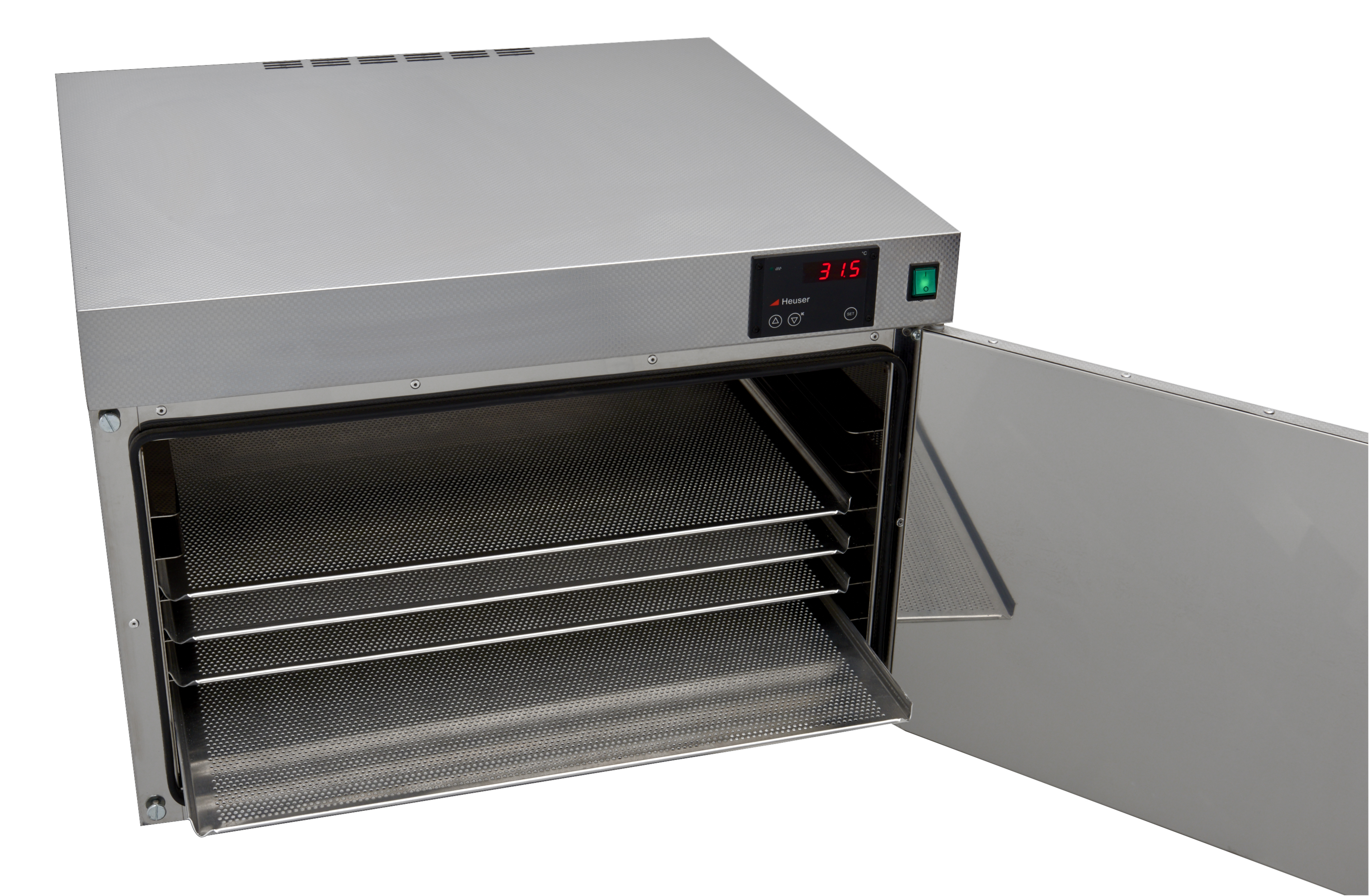
Heuser Heating Cabinet Efficient Warming for Therapeutic Applications The HWS heating cabinets are specifically designed for professional use in physiotherapy, rehabilitation and wellness facilities. They ensure reliable and consistently even heating of fango-paraffin, silicate packs, heat cushions and other therapeutic materials. Thanks to precise electronic temperature control, the desired warmth can be accurately set at any time. Product Variants HWS 6-6040 - 6 shelves, for aluminum trays 60 x 40cm HWS 12-6040 - 12 shelves, for aluminum trays 60 x 40cm HWS 6-7050 - 6 shelves, for aluminum trays 70 x 50cm HWS 12-7050 - 12 shelves, for aluminum trays 70 x 50cm Advantages of the HWS Heating Cabinets Efficient convection technology: Ensures uniform temperature distribution Energy-saving insulation: Reduces heat loss and helps lower power consumptionEasy to clean: High.quality stainless steel housing for optimal hygiene Digital temperature control: Precise settings up to 85°C Multiple sizes available: Adaptable to different professional requirements Application Areas Physiotherapy and Rehabilitation Wellness and Spa-Facilities Hospitals and Clinics All HWS heating cabinets are made in Germany and meet the highest quality standards. They are certified as Class I medical devices and provide safe, reliable heating for professional therapeutic use.
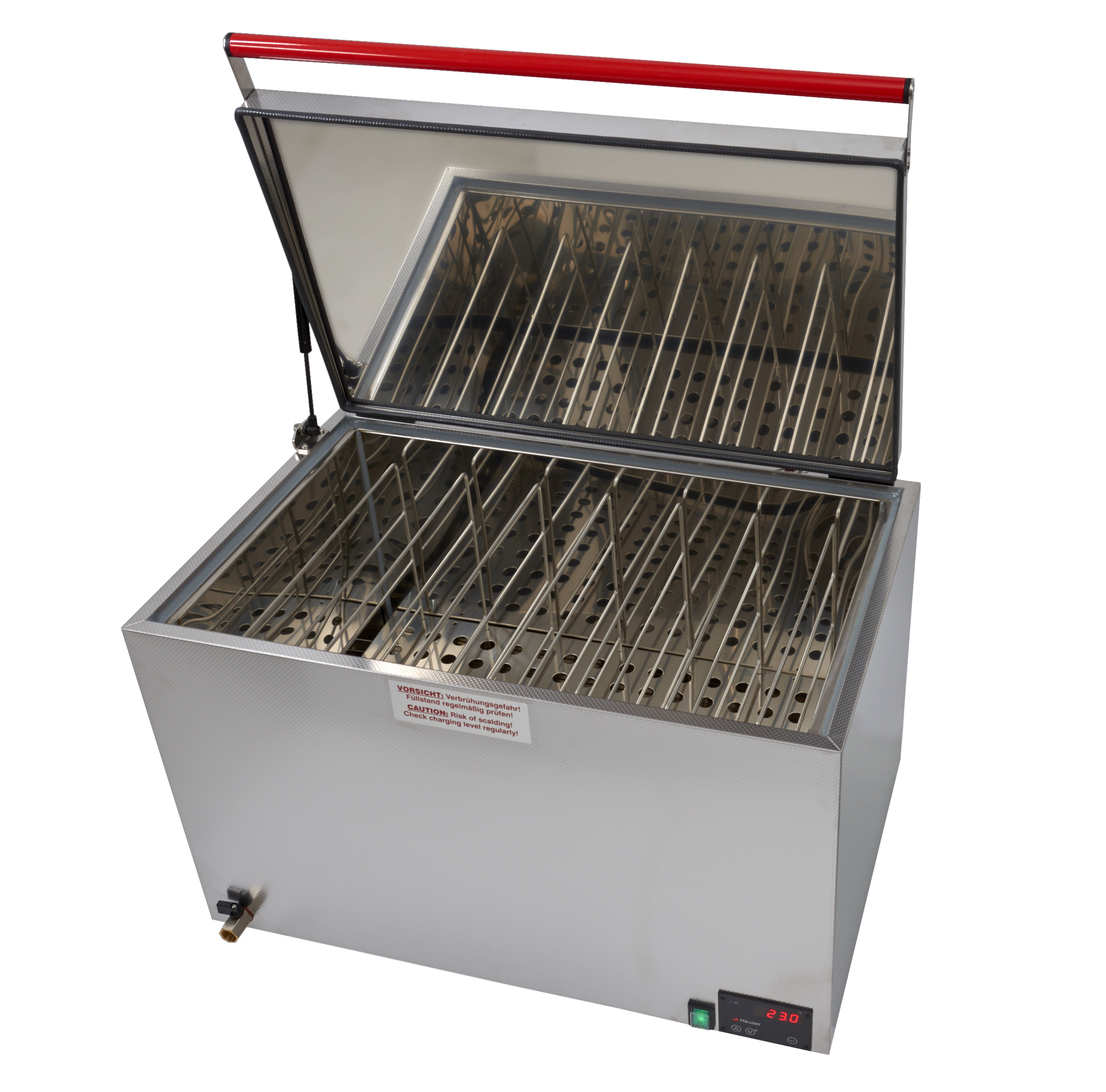
Heating, steaming, and keeping warm with the water bath To easily implement all these things in your practice and to treat your patients in the best possible way, we offer different types of water baths: Type WB: Heating and keeping warm of heat carriers in physiotherapy Type HDS: Steaming of hay packs Type WDB: Steaming of thermoplastic dressings Type PB: Heating and keeping warm of paraffin or paraffin fango Product details: Class I medical device self-supporting outer casing made of pattern-rolled stainless steel lid with handle bar in red, green or black - gas spring* energy-saving insulation against heat loss insulated lid electronic temperature control with digital temperature display* WB 4-30/4 with thermostatic temperature control without temperature display temperature measurement directly in the water* even and fast heating due to large-area silicone heating mat operation control lamp and heating control lamp water drain with chrome-plated ball valve on the front side removable stainless steel insert grate (WB / WDB / HDS) * except WB 4-30/4 Here you will find all the technical data for all our waterbaths and can choose the best one for you: You can also order the following accessories from us: Mobile base, consisting of: - black powder-coated steel frame - 4 castors, 2 of which are lockable - Mounting for appliance feet - Stainless steel shelf If you have any questions, please contact us at any time!

Infrared lamp for physiotherapy applicationsThis Philips infrared PAR38 bulb (E27, 150W) is designed for therapeutic heat treatments and is ideal for use in physiotherapy setting.It serves as a replacement bulb for your Heuser infrared emitter TGS 6.2 or TGS 3.2.
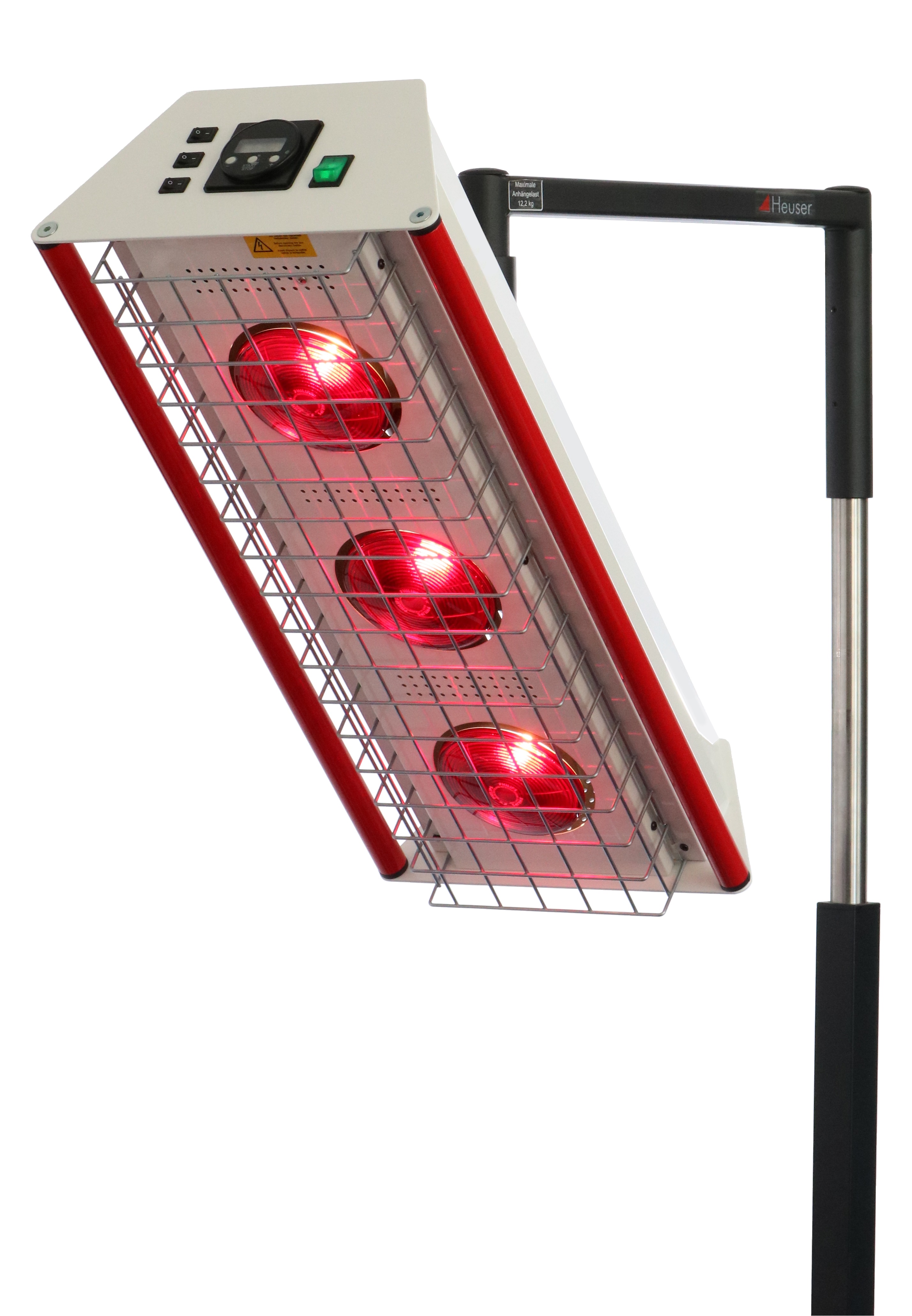
Treat your patients with infrared radiation! The infrared radiators TGS help you to treat your patients in physiotherapy with infrared radiation. Product details: Housing made of powder-coated aluminium/steel plate Colour white Rod handles optionally red, green, or black electronic timer, max. treatment time 60 min. therapeutic lamps Philips Infrared PAR 38, 150 W each lamp individually switchable protective grille against danger of burns main switch with control lamp compatible with the SST / SSU / SSV lamp stand compatible with Heuser wall arm HWA compatible with the ACROBAT 2000 support system from Ondal medical product class IIa - CE0044 All infrared radiators are equipped with a coupling for attachment to the following support systems: Radiation stand SST / SSU / SSV (Heuser Apparatebau GmbH) Wall arm HWA (Heuser Apparatebau GmbH) ceiling arm AC2000 (Ondal Medical System GmbH) We can offer you different models: TGS 3.2: Number of lamps: 3 Heat output: 450 W External dimensions: 710 x 330 x 160 mm (LxDxH) TGS 3.2 with dimmer: Number of lamps: 3 Heat output: 450 W External dimensions: 710 x 330 x 160 mm (LxDxH) TGS 4.2: Number of lamps: 4 Heat output: 600 W External dimensions: 506 x 490 x 160 mm (LxDxH) TGS 4.2 with dimmer: Number of lamps: 4 Heat output: 600 W External dimensions: 506 x 490 x 160 mm (LxDxH) TGS 6.2: Number of lamps: 6 Heat output: 900 W External dimensions: 710 x 490 x 160 mm (LxDxH) TGS 6.2 with dimmer: Number of lamps: 6 Heat output: 900 W External dimensions: 710 x 490 x 160 mm (LxDxH) Optional accessories (also available from us): Electronic dimmer

Treat your patients with infrared light! The IRS halogen infrared radiator makes it easy for you to treat patients in physiotherapy with infrared radiation. Product details: powder-coated housing made of sheet steel/aluminium Housing colour white/black 3 halogen lamps of 200 W each, producing radiation in the therapeutically effective infrared range Each lamp can be switched individually 3 reflectors that distribute the radiation evenly over a large area tested for photobiological safety according to DIN EN 62471 digital timer with repeat function Protection against touching the filter glass pane main switch with control lamp optional accessory: electronic dimmer compatible with spotlight stand SST / SSU / SSV compatible with Heuser wall arm HWA compatible with the ACROBAT 2000 support systems from Ondal Class IIa medical device Halogen infrared radiators IRS are compatible with the following support systems: Radiation stand SST / SSU / SSV (manufacturer Heuser Apparatebau) Wall arm HWA (manufacturer Heuser Apparatebau) Ceiling arm AC2000 (Ondal Medical Systems GmbH)
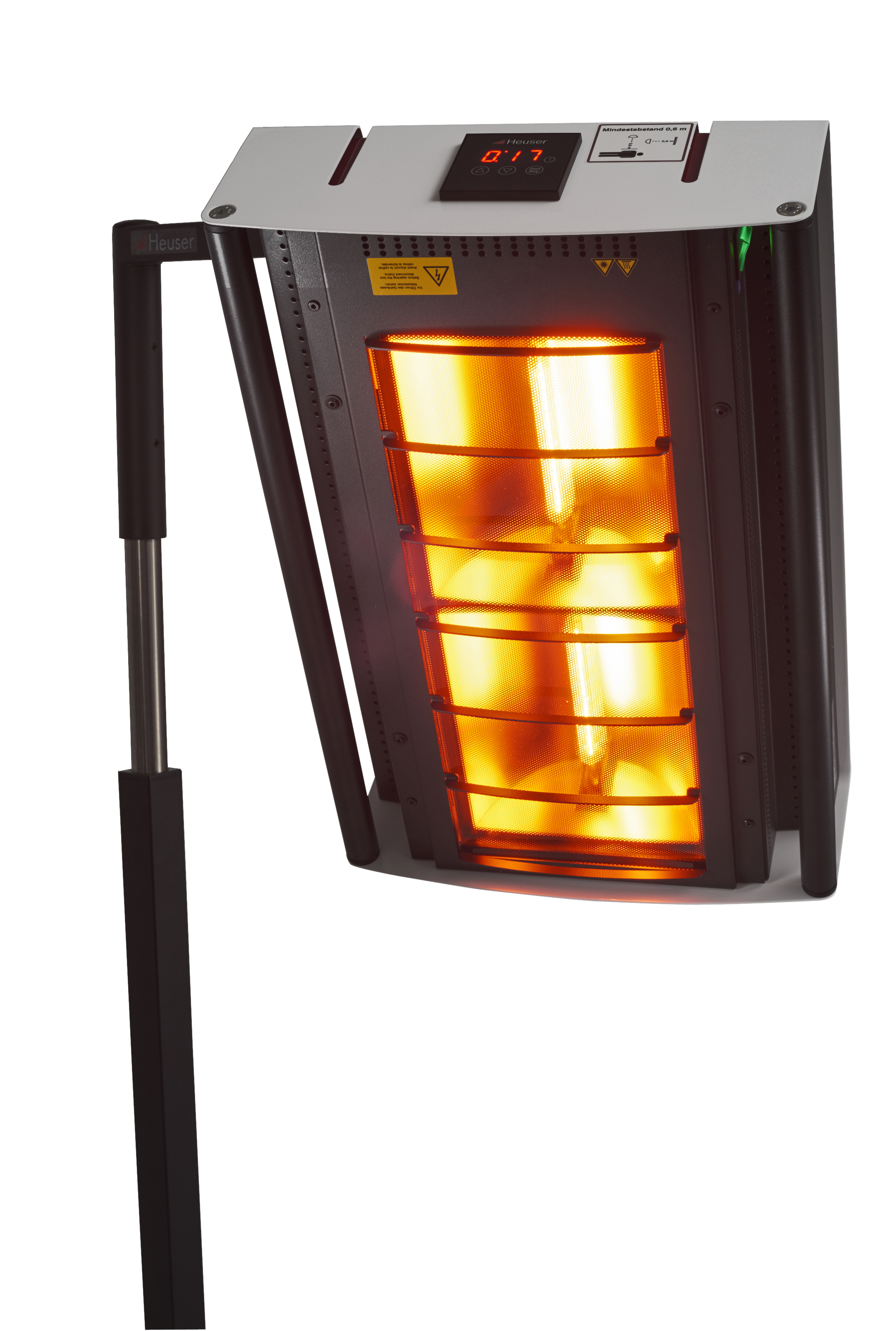
Help your patients with infrared radiation! Make you and your patients in physiotherapy benefit from therapy with infrared radiation. Product details: powder-coated housing made of sheet steel/aluminium Housing colour white/black 2 halogen lamps à 200 W, which produce radiation in the therapeutically effective infrared range 2 reflectors that distribute the radiation evenly over a large area tested for photobiological safety according to DIN EN 62471 digital timer protection against touching the filter glass pane main switch with control lamp compatible with the spotlight stand SST / SSU / SSV compatible with Heuser wall arm HWA compatible with the ACROBAT 2000 support systems from Ondal Medical device class IIa Technical data: Number of lamps: 2 Heat output: 400 W External dimensions 555 x 365 x 145 (mm) IRS halogen radiators are compatible with the following support systems: Spotlight stand SST / SSU / SSV (Heuser Apparatebau) Wall arm HWA (Heuser Apparatebau) Ceiling arm AC2000 (Ondal Medical Systems)
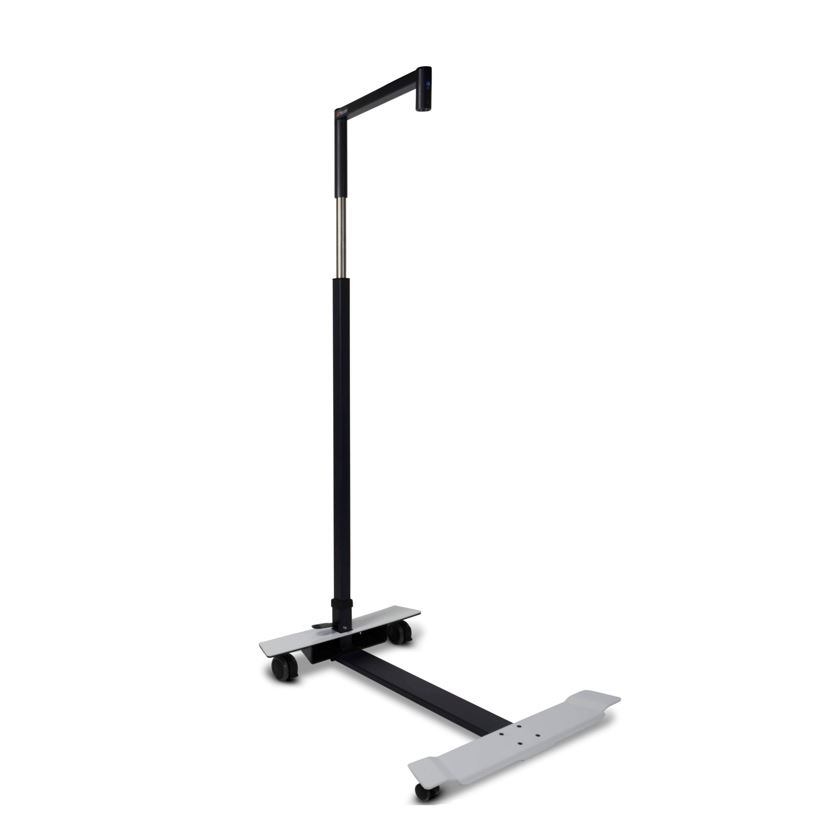
Radiation standThe mobile support system for infrared radiatorsThis radiator stand is suitable for your (halogen) infrared radiator of the Heuser brand. This class I medical product has all the features needed in modern physiotherapy: 4 steerable castors with locking brake Stepless height adjustment from 165.5 cm to 204.6 cm (measured at the upper edge of the stand) Lifting support by gas pressure spring Load capacity up to 12.2 kg Fits under most treatment couches with all-round handle. You have the choice between three different feet: You can get your radiator stand with a T-foot (SST), U-foot (SSU) or V-foot (SSV)!You need a tripod for your Heuser (halogen) infrared spotlight? This heater tripod is the right one for you.Product details: Material: powder-coated steel Colour: white/black Connection for any infrared radiator with Ondal coupling: halogen infrared radiator IRS, halogen infrared radiator IRS 2, infrared radiator TGS Height of stand base at front: 50 mm (SST) or 63 mm (SSU and SSV) Medical device class I Download data sheet Illuminator not included in the scope of delivery
Thermotherapy: an alternative to conventional painkillers
1. When is thermotherapy used?
2. What types of thermotherapy are there?
3. How do I heat a heat transfer medium?
4. How does heat affect the body?
5. What you should bear in mind when using thermotherapy
6. Conclusion
When is thermotherapy used?
Thermal therapy is one of the oldest forms of therapy and is now an integral part of competitive sport and physiotherapy. Heat supports various healing processes and leads to faster regeneration after physical exertion. It is used above all when increased blood circulation is helpful for the recovery of the symptoms. For example, thermotherapy can be used for pain caused by muscle tension or chronic pain. Heat can also be used for injured ligaments, tendons, fascia, capsules or muscles, as it has a relaxing and regulating effect.
Areas of application for thermotherapy:
- For general muscle tension
- After operations and trauma to the musculoskeletal system
- For back pain
- For incomplete paralysis with spasmodically increased muscle tension (spastic paresis), for example as a result of a stroke
- For diseases caused by wear and tear such as osteoarthritis, slipped discs, spinal canal stenosis
- Chronic joint inflammation such as rheumatism (not in the acute stage!)
- For functional organ complaints such as abdominal pain due to irritable bowel syndrome
- For chronic respiratory diseases
- Chronic diseases of the musculoskeletal system
- For restlessness and agitation (psychosomatic illnesses, nervousness)
What types of thermotherapy are there?
Thermal therapy uses various heat carriers to trigger heat stimuli. Measures are often combined to achieve the desired effect. Heat carriers are often used after a massage to loosen the muscles and reduce tension. These include:
Thermotherapy with infrared:
Infrared light generates heat on the part of the body to be treated. In contrast to other forms of thermotherapy, no physical heat carrier is placed directly on the skin, but only the respective part of the body is warmed using the infrared lamp. The infrared light first penetrates the upper layers of the skin and then reaches deeper layers. This promotes blood circulation and increases muscle relaxation.
Moor packs:
Natural moor is a purely natural product. It is contained in so-called moor packs, which are intended for single use. These are firmly pressed natural moor, which is covered with a layer of fleece and can be applied directly to the body. During treatment with peat packs, the heat can penetrate deep into the muscle layers, as it reaches not only the affected area but also the adjacent tissue.
How do I heat a heat transfer medium?
Different heat transfer media are used in thermotherapy. These heat transfer media are usually heated with the aid of a water bath or a heating cabinet. With a water bath, you can heat different heat transfer media such as mud packs evenly and quickly to provide your patient with the best therapy. Heating cabinets are also used in physiotherapy to heat or keep warm heat carriers such as fango kerosene or silicate packs.
How does heat affect the body?
Treatment with heat has a regulating effect on the distribution of heat in both superficial and deep tissue and leads to an intensification of the flow of heat in the body. Initially, the heat is absorbed via receptors in the skin, the thermoreceptors. These then notify our brain that the heat has been received and neurological reactions also reach deeper parts of the body and organs. When exposed to heat, the blood capillaries are opened and blood flow is increased. The increased blood flow then increases the removal of waste products and mediators, which can also lead to faster recovery. Tissue that is poorly supplied with blood or injured can also be better supplied with messenger substances and lead to faster healing. Heat also relaxes the muscles, makes the connective tissue more flexible and increases the fluidity (viscosity) of the synovial fluid. Nerve pathways that run through our body are relieved in this way.
What you should bear in mind when using thermotherapy
For certain illnesses, thermotherapy is only advisable in certain situations. It may therefore be advisable to consult a doctor as a precaution. We recommend that you take particular care with the application of heat in the following cases
- With a slipped disc
- With gout
- With osteoarthritis
- With cardiovascular weakness
- With fever
- With breathing difficulties
- With lymphoedema
- With skin inflammation
- and with high levels of body heat
